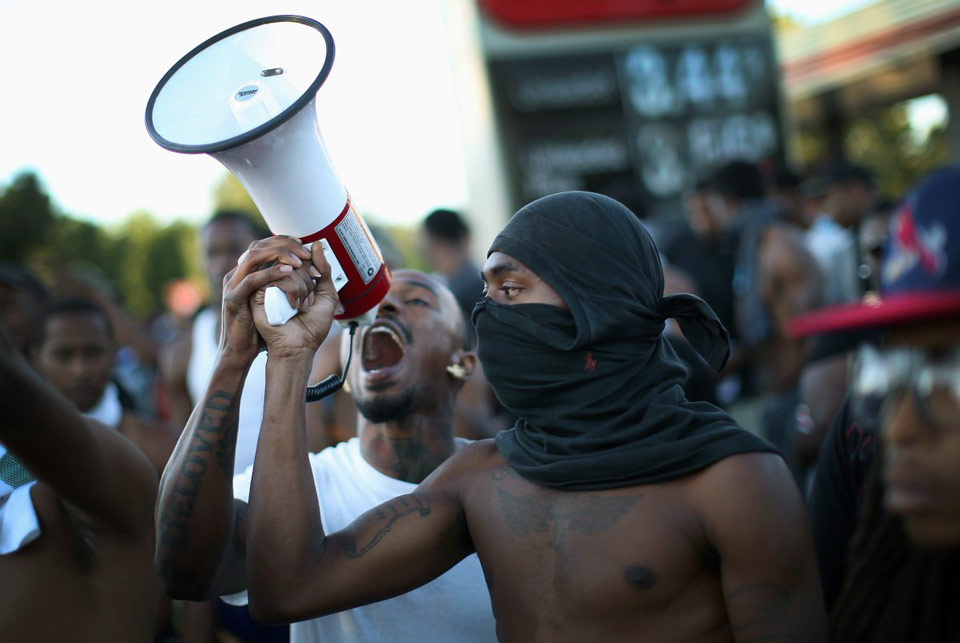
In early 2011, in response to austerity measures, protesters occupied the capitol building in Madison, Wisconsin. It was a localized struggle, but it gained traction on the popular imagination out of all proportion to its size. This clearly indicated that something big was coming, and some of us even brainstormed about how to prepare for it—but all the same, the nationwide wave of Occupy a few months later caught us flat-footed.
In August 2014, after white police officer Darren Wilson killed unarmed black teenager Michael Brown in Ferguson, Missouri, a week and a half of pitched protests shook the town. Once again, these were localized, but they loomed big in the popular imagination. Police kill something like three people a day in the United States; over the past few years, we’ve seen a pattern of increasing outrage against these murders, but until that August it hadn’t gained much leverage on the public consciousness. What was new about the Ferguson protests was not just that people refused to cede the streets to the police for days on end, nor that they openly defied the “community leadership” that usually pacifies such revolts. It was also that all around the country, people were finally paying attention and expressing approval.
Like the occupation of the capitol building in Madison, this may portend things to come. Ferguson is a microcosm of the United States. Could we see an uprising like this spread nationwide? It seems almost possible, right now, as the governor of Missouri has declared a preemptive state of emergency and people all over the US are preparing demonstrations for the day that the grand jury refuses to indict Darren Wilson.
What limits did the Occupy movement reach? Why did it subside without achieving its object of transforming society? First, it offered almost no analysis of racialized power, despite the central role of race in dividing labor struggles and poor people’s resistance in the US. Second, perhaps not coincidentally, its discourse was largely legalistic and reformist—it was premised on the assumption that the laws and institutions of the state are fundamentally beneficial, or at least legitimate. Finally, it began as a political rather than social movement—hence the decision to occupy Wall Street instead of acting on a terrain closer to most people’s everyday lives, as if capitalism were not a ubiquitous relation but something emanating from the stock market. As a result of these three factors, the majority of the participants in Occupy were activists, newly precarious exiles from the middle class, and members of the underclass, in roughly that order; the working poor were notably absent. The simplistic sloganeering of Occupy obscured the lines of conflict that run through our society from top to bottom: “police are part of the 99%” is technically true, economically speaking, but so are most rapists and white supremacists. All of this meant that when the police came to evict the encampments and kill the movement, Occupy had neither the numbers, nor the fierceness, nor the analysis it would have needed to defend itself.
When a movement reaches its limits and subsides, it illustrates the obstacles future movements will have to surpass. It’s possible to understand the social momentum originating in Ferguson as an answer to the failures of Occupy. Where Occupy whitewashed the issue of race, the protests in Ferguson placed it front and center. Where Occupy confined itself to the unfavorable terrain of “political” physical sites and reformist demands, the people who rose up in Ferguson were fighting on their own streets for their own very lives. Whereas, with the temporary exception of Occupy Oakland, Occupy lacked the will to stand down the police, people in Ferguson braved tear gas and even bullets to do just that. Where Occupy sought to conceal all the different forms of hierarchy and strife that cut through this society beneath the unifying banner of “the 99%,” the conflicts in Ferguson compelled everyone to confront them. Even if it doesn’t arise in response to the grand jury verdict on Darren Wilson, the next powerful social movement in the US will likely have more in common with what we’ve seen in Ferguson than with Occupy (or its ersatz sequels, like the self-policing, pre-pacified People’s Climate March).
The momentum proceeding from the demonstrations in Ferguson has its own internal tensions, which will become more apparent the further it goes. Is the problem police brutality, or policing itself? Is the rightful protagonist of this struggle the local poor person of color, the respectable leader of color, the white ally, or everyone who opposes police killings? If it is the latter, how should we deal with the power imbalances within this “everyone”? How should demonstrators from outside the most targeted communities relate to conflicts playing out within them, such as disputes over tactics or risk? And do we really have to repeat the debate about violence and nonviolence yet again?
Right now, authorities of all stripes around the US are scrambling to capitalize on those fault lines to neutralize a potential second wave of unrest in response to the murder of Michael Brown. They intend to manage our rage and heartbreak, to channel it into contained protests that will function as a mere pressure valve—like the people who held signs at Occupy for a few months before returning to their lives as atomized individuals. If they succeed, it will embolden police departments nationwide to go on killing people, especially young black men, and it will take the question of transforming society off the table once more. The stakes are high.


